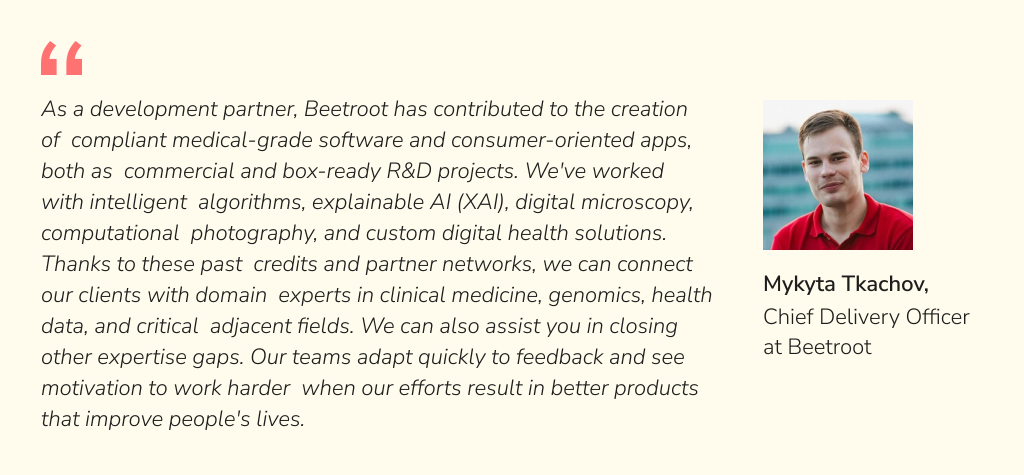
Navigating Success: Essential Factors in Selecting Your Assistive Healthcare Tech Partner
Contents
Contents
The market for assistive health technology is one of the world’s fastest-growing industries, spurred by the demand for tech solutions like apps, wearables, trackers, and living aids that create a world of opportunities for people with and without disabilities to manage their health and wellness.
However, choosing the right provider can take time and effort, with so many custom healthcare software development companies available. Clutch, a trusted B2B research, ratings, and reviews site, lists 6,281 of these firms. Prioritizing factors such as domain expertise, commitment to inclusivity, and a sustainable development approach will be essential.
Today’s article aims to delve into these critical considerations, guiding you toward selecting a development partner capable of delivering HealthTech solutions that are not only innovative and effective but also secure, accessible to all, and designed to last.
The role of tech partnerships in assistive healthcare app development
Because the healthcare industry is complex and heavily regulated, software development in this field presents a unique challenge. Unlike other solutions, healthcare applications have a direct impact on patient outcomes, data privacy, and access to care. To create an inclusive HealthTech product, developers need to have a deep understanding of the nuanced needs of patients, medical professionals, and healthcare systems as a whole. Failure to address these needs or comply with industry regulations can render a product irrelevant or even harmful.
However, the daily challenges faced by people with disabilities are sadly not always understood. Assistive technology, representing the intersection of innovation and disability, creates unique opportunities to develop products and services designed for a more accessible world. One way to achieve this is by building tech partnerships within the assistive tech sector. By connecting people with disabilities, startups, investors, research institutions, academia, and tech companies, we can create innovative solutions that meet real-world needs.
Factors to consider when sourcing a healthcare app development partner
The journey to developing inclusive HealthTech products requires a multidisciplinary team with diverse skills. Collaboration, domain and accessibility expertise, compliance knowledge, a commitment to diversity, continuous learning, and cost efficiency are key elements for product success in the competitive healthcare market.
Domain expertise and access to talent
To be an expert in health technology, one must possess a thorough understanding of healthcare processes, patient requirements, and relevant technology. This approach guarantees that product development remains focused on enhancing healthcare outcomes. When selecting a HealthTech vendor, prioritize those who can bridge expertise gaps quickly. This can be achieved by leveraging established sourcing channels, engaging subject matter experts from affiliated networks, upskilling and learning opportunities, and customized recruitment practices.
Engaging subject matter experts
When developing assistive technology, teams need to have expertise in disability and related areas of knowledge. In the healthcare IT field, subject matter experts (SMEs) typically have clinical, technical, or scientific backgrounds and/or skills with medical software such as electronic health records. They can also be experts in health policy, regulations, and healthcare management. Within a team, SMEs will seek input from other colleagues to ensure that healthcare software meets the needs of stakeholders and adheres to applicable standards and regulations. A prime example of introducing subject matter experts is Beetroot’s collaboration with the AI Genomics Company. Two years ago, a geneticist joined an existing team of dedicated developers and data scientists. Since then, they have worked closely with the client’s team and incorporated their work into the machine learning algorithms that will become part of AI-powered genomics products.

Embracing codesign and collaboration
Involving users and stakeholders in the development process is crucial for building user-centric, accessible apps. Their feedback helps enhance usability, functionality, and satisfaction, fostering trust and loyalty. Collaborating with patients and people with lived experiences ensures products meet their specific needs, offering insights into the user journey for more sensitive solutions. Furthermore, products designed with users’ participation are less likely to be abandoned.
Engaging people with disabilities or health conditions in the development of assistive technology ensures that solutions are created with their comfort in mind, leading to more practical and user-friendly products with positive ripple effects. You can start doing this by employing user-oriented design and allowing people with disabilities to contribute. Analysis of client needs and current trends helps us in R&D: Beetroot’s in-house projects, Eshmun and Speak’n’Hear, are examples of solutions inspired by real-life scenarios.
Accessibility expertise
Creating inclusive Health Tech products requires expertise in accessible software development and input from stakeholders, among them patients, healthcare providers, and accessibility advocates. By leveraging this knowledge, you can ensure that the product meets accessibility standards and provides a seamless experience for all users, regardless of their abilities.
In healthcare app development, making tools accessible does more than improve the user journey— it directly leads to better patient outcomes. The POUR principle in accessibility offers a structured framework for designers and developers to create accessible digital content:
- Perceivable: make content visible and accessible to all users;
- Operable: offer barrier-free interactions for diverse user needs;
- Understandable: make navigation and operation intuitive for users;
- Robust: ensure compatibility with current and future assistive technologies.
Expanding accessibility through inclusive design
A deep understanding of the extensive spectrum of disabilities that users may have is a determinant of successful healthcare app development. That knowledge enables developers to tailor their solutions to suit the diverse requirements of all healthcare app users. Emphasizing inclusivity as a core aspect of healthcare app development can significantly improve the user experience for all. Creating products for users with permanent disabilities can yield results that benefit everyone. For instance, high-contrast screen settings, initially designed to assist individuals with low vision, facilitate general users to use a device in bright sunlight. This same principle applies to other features such as voice assistants, gesture controls, and text-to-speech functionalities.

Compliance expertise and knowledge of regulatory standards
An unwanted record of 725 large healthcare data breaches was set in 2023, making cybersecurity one of the greatest concerns within the industry. A team with strong compliance expertise ensures that the product not only meets legal requirements but also upholds the highest standards of data privacy, security, and patient safety. This expertise minimizes risk, builds trust with users, and facilitates a smoother path to market for innovations. Consider selecting a development partner who can assist you in achieving compliance, especially if you don’t have an in-house expert. Such a partner can connect you with legal consultants and provide additional support in this area.
WCAG & ADA
WCAG outlines three tiers of accessibility—A, AA, and AAA—with AAA being the highest and most comprehensive standard. When the target audience has a disability, developers must strive for triple-A compliance. In the UK, public sector apps, including those for the National Health Service, must meet WCAG AA standards. In the US, the ADA aims to ensure equality for people with disabilities. While not formally adopted, WCAG A and AA levels serve as the de facto standards for ADA compliance.
HIPAA compliance
The Health Insurance Portability and Accountability Act, or HIPAA, sets strict guidelines for safeguarding patient data. To comply with these standards, developers of healthcare applications need to prioritize data protection and implement strong encryption methods.
FDA regulations
If your application’s features relate to medical devices or software that affect clinical decision-making, it might fall under the jurisdiction of the FDA (the U.S. Food and Drug Administration). Therefore, UX designers must work closely with regulatory experts to ensure that the application adheres to all the necessary standards for approval.
Interoperability standards
With the push for healthcare interoperability, designers and app developers must consider standards like FHIR (Fast Healthcare Interoperability Resources) to ensure seamless data exchange between healthcare systems, improving overall coordination of patient care.

Sustainability mindset
When selecting a vendor, it is important to choose partners who not only offer high-quality services and products but also share a commitment to diversity and inclusion, viewing them as part of their core values. This results in a wider range of perspectives on product development. Collaborating with such partners can increase creativity, encourage a more inclusive approach to product design, and ensure that the HealthTech solution meets the needs of a diverse user base, reinforcing the mission to create a tangible and lasting impact.
On a higher level, promoting inclusion has a direct link to realizing the Sustainable Development Goals (SDGs) and leaving no one behind. Greater access to assistive technology is particularly relevant to accelerating progress on SDG 1 (No Poverty), SDG 3 (Good Health and Well-Being), SDG 4 (Quality Education), SDG 8 (Decent Work and Economic Growth), SDG 9 (Industry, Innovation, and Infrastructure), and SDG 10 (Reduced Inequality).
Budget-friendly team hiring options
Developing an inclusive HealthTech product doesn’t necessarily have to break the bank. Various cost-effective options are available to build an expert team, including hiring freelancers for specific tasks, outsourcing certain development aspects to countries with lower labor costs (a prime example is Vietnam), and engaging remote dedicated teams and experts through reliable vendors. These strategies can assist in managing the budget efficiently while still enabling access to top-notch talent and resources.
Summing up, companies looking to create transformative healthcare applications can benefit immensely from collaborating with a reliable and competent development partner, one that not only navigates the complexities of the industry but also shares your vision and can amplify your impact. With evolving technologies, the right collaboration can transform challenges into opportunities in healthcare, leading to innovative solutions that exceed expectations and genuinely improve lives. Ready to make a difference? Let’s connect and explore how Beetroot can contribute to your journey.
Subscribe to blog updates
Get the best new articles in your inbox. Get the lastest content first.
Recent articles from our magazine
Contact Us
Find out how we can help extend your tech team for sustainable growth.





